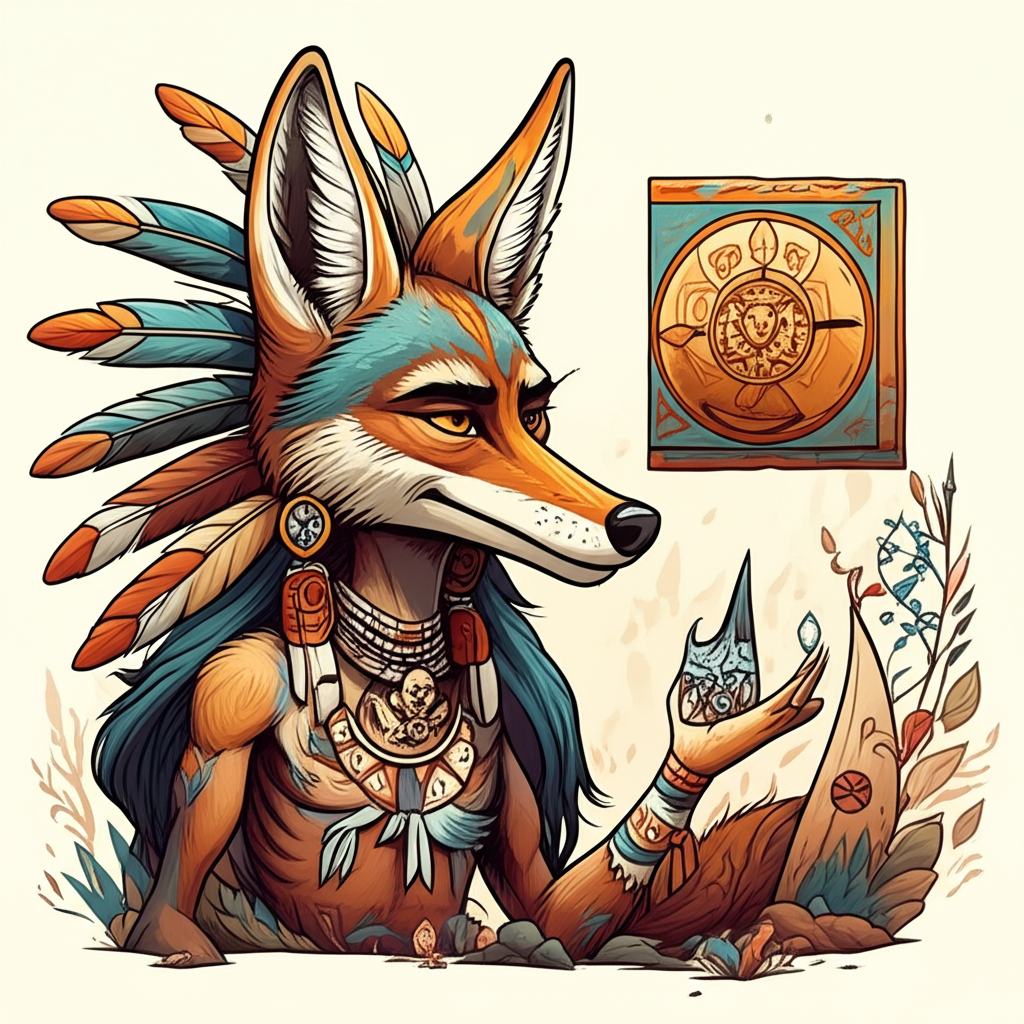
1. Introduction
This article delves into a fascinating realm of traditional storytelling, exploring a narrative that intertwines the enigmatic figure of Coyote, the archetypal trickster, with the profound spiritual teachings associated with the White Buffalo Prophecy. This rich tapestry of myth and legend originates primarily from the diverse Indigenous cultures of North America, particularly those of the Great Plains, where such stories served as foundational elements of cultural identity and moral instruction. It is crucial to understand that this is a traditional story, a product of ancient peoples’ imaginative and philosophical world, told and retold through generations, and presented here solely for cultural, historical, and educational understanding.
2. Origins and Cultural Background
The myths surrounding figures like Coyote and the White Buffalo Calf Woman emerged from a pre-colonial era when Indigenous societies lived in intimate communion with the natural world. For these ancient peoples, the environment was not merely a resource but a living, breathing entity imbued with spiritual significance. Their worldview was holistic, perceiving an intricate web of relationships between humans, animals, plants, and the cosmos. Every creature, every natural phenomenon, held lessons and spiritual power. Stories were not mere entertainment; they were repositories of knowledge, history, ethics, and spirituality, transmitted orally around campfires, in ceremonies, and during daily life. They explained creation, justified customs, and taught children how to navigate their world, fostering a deep respect for balance, community, and the interconnectedness of all existence.
3. Character / Creature Description
In this narrative, two potent figures stand central. First, there is Coyote, a ubiquitous character in the mythologies of countless North American tribes. Coyote is the quintessential trickster: a shapeshifter, an intelligent yet often foolish being, a creator and a destroyer, a culture-hero and a chaotic force. He embodies duality – capable of great wisdom and profound stupidity, generosity and selfishness, heroism and cowardice. Coyote is the one who often inadvertently brings about change, sometimes for the good (like bringing fire or teaching people how to hunt), but more often through his insatiable curiosity, greed, or mischief, which frequently leads to comedic or disastrous consequences. His symbolic attributes represent the unpredictable nature of life, the breaking of norms, and the learning that often comes through error or negative example.
Opposite to Coyote’s chaotic energy, and central to the "Oath of White Buffalo Prophecy," is the spirit of the White Buffalo Calf Woman. While not directly a creature in the trickster sense, her manifestation often involves the sacred White Buffalo. This revered figure, particularly in Lakota traditions, is a sacred bringer of peace, harmony, and the holy pipe, teaching people the sacred ceremonies and how to live in balance with each other and the Earth. Her symbolic attributes are purity, spiritual guidance, abundance, and the promise of renewal and a harmonious future. The prophecy associated with her often speaks of the return of the white buffalo as a sign of impending spiritual renewal and the restoration of balance.
4. Main Story / Narrative Retelling
In the ancient times, when the People of the Plains faced a period of great hardship – the buffalo herds were scarce, the waters were low, and discord began to sow seeds of mistrust among the lodges – a profound spiritual hunger settled upon the land. It was then, amidst this despair, that a sacred being appeared, radiating a light that pierced the gloom. She manifested as a beautiful woman, carrying a bundle, and in some tellings, transformed into a White Buffalo Calf, a creature of immense rarity and spiritual significance. This was the White Buffalo Calf Woman, who brought with her the Sacred Pipe and a bundle of teachings that promised to restore balance and abundance.
She taught the people the seven sacred rites – ceremonies for healing, purification, kinship, and prayer – and instructed them on how to live in harmony with the Earth, with each other, and with the Great Mystery. She spoke of respect, generosity, courage, and wisdom. Before her departure, she gave a solemn prophecy: that one day, when the world was again out of balance, a white buffalo calf would be born, signaling a time of spiritual renewal and the coming together of all peoples. The people, moved by her wisdom and the promise of a brighter future, took an Oath to uphold her teachings, to keep the Sacred Pipe holy, and to prepare their hearts for the prophecy’s fulfillment. This was the Oath of the White Buffalo Prophecy – a sacred commitment to live right, to honor all life, and to await the sign of renewal.
Coyote, ever present and ever observant, watched all of this unfold from the periphery. He had witnessed the People’s despair, then their newfound hope and solemn commitment. "Hmph," he thought, his ears twitching, "such serious faces, such grand promises. Surely, such unwavering devotion cannot last." Boredom, or perhaps a mischievous urge to test the limits of this new harmony, stirred within him.
He decided to test the "Oath." One day, as the people gathered for a sacred ceremony, holding their pipes and offering prayers for the return of the buffalo, Coyote transformed himself. He did not appear as his usual scruffy self, but rather as a sleek, powerful black wolf, his eyes gleaming with a false promise of an easy hunt. He stalked the edges of the camp, tempting the young hunters with visions of massive herds, but only if they abandoned their prayers and followed him into a forbidden valley. "Why waste time with smoke and words," he whispered into their dreams, "when I can show you where the meat runs thick and easy, if you but forget your rigid rules?"
Later, he took the form of a disgruntled elder, grumbling about the scarcity of game despite all the new prayers. He sowed seeds of doubt, questioning the efficacy of the White Buffalo Calf Woman’s teachings. "Perhaps," he murmured, "this ‘Oath’ is just another burden, keeping us from our true instincts, from seeking our own paths, even if they are quicker and less pious." He subtly encouraged selfishness, whispered of breaking the communal sharing, and suggested that personal gain was more important than collective harmony.
Yet, despite Coyote’s clever deceptions and persistent provocations, the People remembered the Sacred Pipe. They remembered the warmth of the White Buffalo Calf Woman’s teachings. Though some felt the sting of doubt, and a few were tempted to follow the black wolf’s lure, the elders and the wisdom keepers held firm. They recounted the stories, rekindled the spirit of the Oath, and reminded everyone of the true path to abundance – not through greed or shortcuts, but through respect, gratitude, and communal living. The young hunters, after briefly considering the wolf’s tempting offer, chose to return to their elders, understanding that true sustenance came from spiritual balance, not from abandoning their sacred commitments. The grumbling elder’s words, though unsettling, were eventually dismissed as the ramblings of a troubled spirit, for the community’s resolve to uphold the Oath was stronger.
Coyote, witnessing the unwavering commitment of the people, despite his best efforts to disrupt it, eventually retreated. He had failed to break the Oath. He had stirred the waters, but the deep currents of faith and tradition proved too strong. Perhaps, he mused as he vanished into the shadows, some things were meant to endure, even the most sacred of promises.
5. Symbolism and Meaning
This narrative, like many Indigenous myths, is rich with symbolism. Coyote, the trickster, represents the chaotic, unpredictable forces of life, the temptations, doubts, and disruptions that constantly challenge human resolve. He teaches through negative example, highlighting the consequences of selfishness, impatience, and deceit. His presence in the story underscores the idea that even the most sacred paths are not without their tests and trials. The White Buffalo Prophecy and the associated Oath symbolize hope, spiritual renewal, peace, and the profound importance of living in harmony with nature and community. It represents a spiritual contract, a commitment to a way of life that ensures collective well-being and a sustainable future. The interaction between Coyote and the Oath signifies the ongoing struggle between chaos and order, the constant need for vigilance and commitment to spiritual values in the face of temptation, and the resilience of a people’s faith and tradition.
6. Modern Perspective
Today, these myths continue to resonate. Coyote, as a trickster figure, is frequently reinterpreted in contemporary literature, art, and even popular culture, often appearing as a mischievous character who challenges norms and exposes societal flaws. The symbolism of the White Buffalo Prophecy has gained significant prominence, particularly in Native American revitalization movements, serving as a powerful emblem of hope, resilience, and spiritual awakening. The birth of actual white buffalo calves in recent decades is often viewed as a living fulfillment of the ancient prophecy, inspiring renewed commitment to Indigenous spiritual paths and environmental stewardship. These stories are studied in cultural anthropology, religious studies, and literary courses, offering invaluable insights into Indigenous worldviews, storytelling traditions, and their enduring spiritual wisdom.
7. Conclusion
The story of Coyote and the Oath of White Buffalo Prophecy is a profound testament to the power of cultural storytelling. It is a narrative from a rich heritage, a reflection of how ancient peoples understood their world, their challenges, and their aspirations. It is not presented as a belief system, nor are its figures to be worshipped or validated as divine. As Muslims, we recognize that only Allah (God) is the true Creator and Sustainer of all existence, and all power and guidance ultimately reside with Him. This story, therefore, stands as a beautiful example of human imagination, the enduring legacy of cultural heritage, and the universal quest for meaning, morality, and harmony through the timeless art of narrative.





